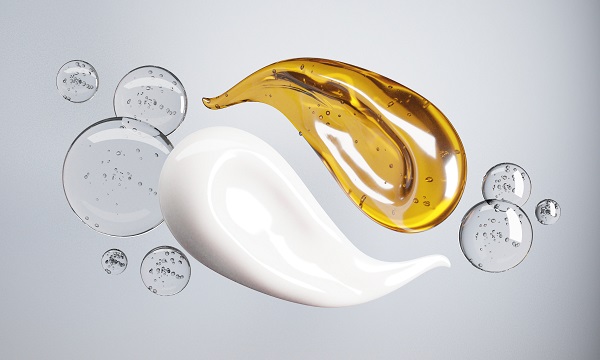The Science Behind Emulsifiers and Their Significance in Everyday Products
Emulsifiers are important components that enable the blending of oil and water, 2 usually immiscible materials. Their special molecular structure permits them to lower surface area tension, creating steady solutions in numerous products. This function is crucial for preserving the wanted structure and high quality in food, cosmetics, and drugs. emulsifiers. As the demand for ingenious formulas grows, recognizing the science behind emulsifiers comes to be significantly crucial. What ramifications might this have for future product growth?

What Are Emulsifiers?
Emulsifiers are materials that enable the mixing of two immiscible liquids, such as oil and water, producing a steady mix referred to as a solution. These agents play a vital duty in numerous sectors, including food, cosmetics, and drugs. Emulsifiers have unique molecular structures, normally including both hydrophilic (water-attracting) and hydrophobic (water-repelling) parts. This double nature allows them to communicate with both kinds of fluids, assisting in the formation of solutions and avoiding separation.
Typical instances of emulsifiers consist of lecithin, typically found in egg yolks, and mono- and diglycerides, which are frequently made use of in baked products. In food, emulsifiers boost appearance and consistency, enhancing overall quality. In cosmetics, they aid in developing stable creams and lotions. The adaptability of emulsifiers makes them necessary in generating a large range of daily items, guaranteeing that numerous active ingredients mix effortlessly for suitable efficiency and customer complete satisfaction.
Just How Do Emulsifiers Function?
Just how do emulsifiers produce secure blends from two typically unmixable liquids? Emulsifiers operate by reducing the surface stress between oil and water, which are naturally inappropriate due to their molecular structures. They possess both hydrophilic (water-attracting) and hydrophobic (water-repelling) buildings, permitting them to connect with both phases. When an emulsifier is presented to a combination of oil and water, its particles position themselves at the user interface, with the hydrophilic end in the water and the hydrophobic end in the oil. This setup supports the solution by protecting against the oil droplets from coalescing and dividing from the water stage. The result is an uniform blend, known as a solution, which can be either oil-in-water or water-in-oil, depending on the primary phase. As a result, emulsifiers play a necessary role in various items, ensuring uniformity and stability in formulations varying from food products to cosmetics.
Sorts of Emulsifiers in Food Products
In the domain name of food manufacturing, various kinds of emulsifiers are employed to improve structure, stability, and overall high quality. These emulsifiers can be categorized primarily right into natural and artificial kinds. All-natural emulsifiers, such as lecithin, derived from soybeans or egg yolks, are typically made use of in products like mayonnaise and chocolates. They are preferred for their clean tag appeal and functional advantages.
Artificial emulsifiers, like mono- and diglycerides, are usually utilized in processed foods for their cost-effectiveness and adaptability. These compounds aid keep the preferred consistency in products such as margarine and salad dressings. Additionally, polysorbates, one more classification of artificial emulsifiers, improve the security of emulsions in gelato and sauces. Each kind of emulsifier plays a crucial function in guaranteeing the wanted sensory qualities and shelf-life of food products, ultimately boosting the consumer experience.
The Function of Emulsifiers in Cosmetics
While the main function of emulsifiers in cosmetics is to blend oil and water-based ingredients, their effect expands past plain stablizing. Emulsifiers act as necessary components that boost the structure and uniformity of products such as creams, creams, and products. By developing a stable mix, they permit consistent distribution of active ingredients, making sure that customers obtain the designated advantages of the formulation.
Furthermore, emulsifiers add to the sensory experience of cosmetic items. They can influence the feel look at here and absorption of an item on the skin, offering a smoother application and a much more appealing coating. In addition, emulsifiers play a duty in expanding the life span of cosmetics by preventing the separation of active ingredients, consequently maintaining item stability gradually. This stabilization is important for customer safety and security and efficiency, making emulsifiers essential in the formula of top quality cosmetic items.
Benefits of Utilizing Emulsifiers
Emulsifiers use many benefits that prolong past their foundational function in cosmetics. These substances enhance the security and structure of numerous items, guaranteeing an uniform uniformity that is visually appealing and functionally efficient. In foodstuff, emulsifiers add to boosted mouthfeel and prolong life span by avoiding splitting up of components, which is crucial for preserving top quality and safety. Furthermore, emulsifiers can help with the absorption of nutrients in nutritional formulas, maximizing their wellness advantages.
In the pharmaceutical market, emulsifiers play a fundamental duty in medication shipment systems, boosting the bioavailability of active ingredients. They also help in developing individual treatment items, guaranteeing that active components are uniformly distributed for maximum effectiveness. In general, the unification of emulsifiers greatly improves item performance across diverse applications, making them vital in daily items. Their multifunctional nature underscores their importance in improving both consumer experience and product long life.
Typical Emulsifiers and Their Sources

In comparison, synthetic emulsifiers like mono- and diglycerides are stemmed from glycerol and fats. These emulsifiers are typically used in processed foods for their effectiveness and cost-efficiency. Polysorbates, one more synthetic alternative, are widely utilized in numerous applications, including pharmaceuticals and cosmetics. Each kind of emulsifier serves specific practical duties, ensuring security and uniformity in the formulas of daily items.
Future Patterns in Emulsifier Research Study and Growth

Furthermore, developments in biotechnology are leading the way for the advancement of customized emulsifiers that enhance stability and structure while lessening environmental influence. This trend is matched by an expanding rate of interest in operation waste products from food production as potential emulsifier sources, therefore promoting a round economic climate.
Consumer awareness relating to health and wellness and health is driving the demand for emulsifiers that support nutritional profiles, such as those that can provide useful advantages. As these patterns evolve, the future of emulsifier research will likely highlight both sustainability and performance, satisfying the altering demands of consumers and industries alike
Often Asked Concerns
Are Emulsifiers Safe for Intake in Food Products?
Emulsifiers are typically thought about secure for consumption in food products. Regulative firms review their use, guaranteeing they satisfy security requirements. Nonetheless, private level of sensitivities might vary, requiring caution for those with particular nutritional constraints or allergies.
Can Emulsifiers Reason Allergic Reactions in Some Individuals?

Exactly How Do Emulsifiers Affect the Shelf Life of Products?
Emulsifiers More Help enhance product security by avoiding splitting up of components, which can extend rack life. Their capacity to maintain harmony helps safeguard tastes and textures, eventually contributing to the durability of various food and cosmetic products.
Exist Natural Alternatives to Synthetic Emulsifiers?
All-natural options to artificial emulsifiers include active ingredients like lecithin, guar gum, and xanthan gum tissue. These compounds can properly support mixes, providing alternatives for those looking for to stay clear of artificial additives while preserving product consistency and quality.
What Rules Control making use of Emulsifiers in Food and Cosmetics?
Emulsifiers in food and cosmetics are regulated by companies like the FDA and EFSA, which establish safety evaluations, permitted quantities, and labeling demands to ensure consumer safety and security and product efficiency across various markets.
In food items, emulsifiers enhance texture and consistency, enhancing general high quality. Additionally, emulsifiers play a role in expanding the shelf life of cosmetics by stopping the separation of active ingredients, therefore preserving product stability over time. In food items, emulsifiers add to boosted mouthfeel and prolong shelf life by stopping splitting up of active ingredients, which is crucial for preserving top quality and safety. In general, the unification of emulsifiers significantly improves item efficiency throughout diverse applications, making them indispensable in daily items. Emulsifiers are usually thought about risk-free for intake in food items.